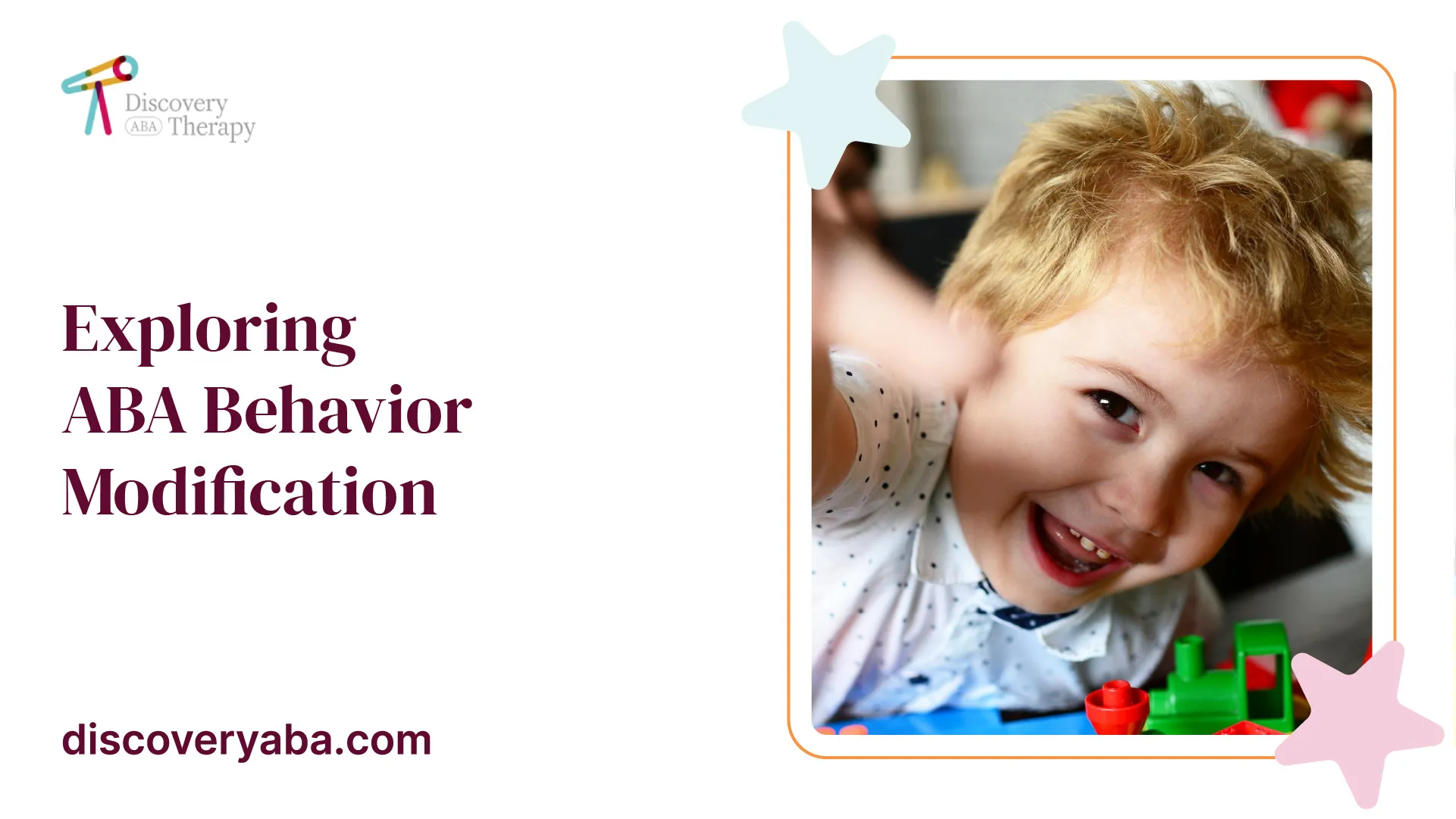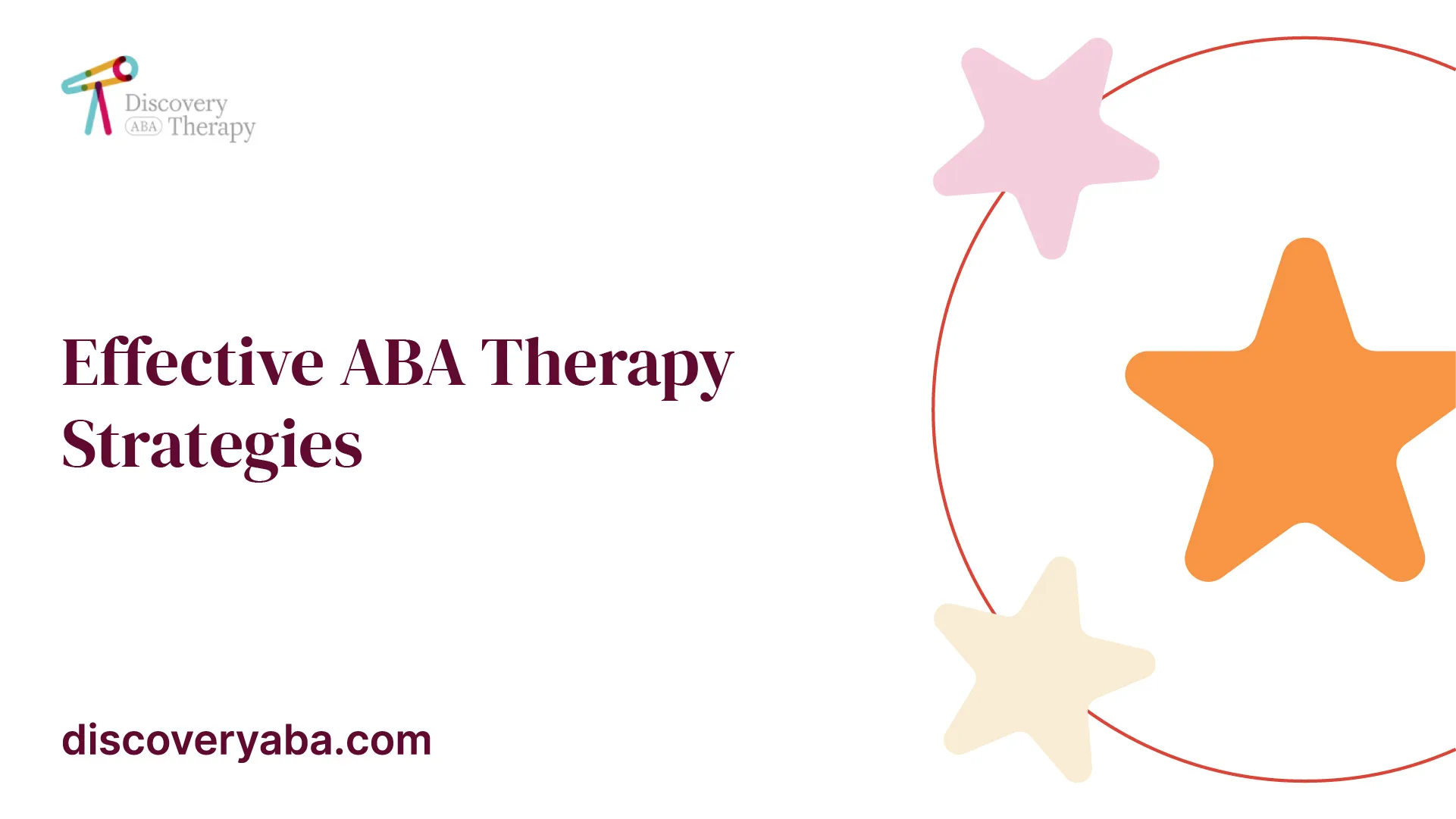Exploring ABA Behavior Modification
Discover the power of ABA behavior modification! Unleash positive change with evidence-based techniques and effective strategies.


Understanding ABA Techniques
When it comes to ABA (applied behavior analysis) therapy, various techniques are employed to facilitate behavior modification and skill development in individuals with autism. In this section, we will explore three fundamental ABA techniques: positive and negative reinforcement, video modeling, and prompting and fading.
Positive and Negative Reinforcement
Positive and negative reinforcement are widely used ABA techniques that help individuals with autism understand appropriate and inappropriate behaviors. Positive reinforcement involves providing a reward or praise when a desired behavior is exhibited. This reinforces the behavior and increases the likelihood of its recurrence. For example, a child may receive a small treat or verbal praise for completing a task independently.
Negative reinforcement, on the other hand, involves removing an aversive stimulus when a desired behavior occurs. This also increases the likelihood of the behavior being repeated. An example of negative reinforcement is turning off a loud noise when a child follows instructions promptly.
Consistency in applying consequences is crucial for the effectiveness of positive and negative reinforcement. By focusing on reinforcing positive behaviors, individuals with autism can learn and generalize appropriate behaviors more effectively. For more information on ABA strategies, refer to our article on ABA strategies.
Video Modeling
Video modeling is an ABA teaching technique that can be particularly beneficial for visual learners. It involves using videos to demonstrate and teach various skills and behaviors to individuals with autism. By watching the videos, individuals can imitate the behaviors and actions they see, helping them learn social interactions, emotional expressions, and other skills.
Video modeling allows for repeated exposure to desired behaviors, providing individuals with the opportunity to practice and reinforce those behaviors. It can be especially useful for teaching complex skills or social situations that may be challenging for individuals with autism to grasp. To learn more about video modeling and its applications, check out our article on ABA intervention techniques.
Prompting and Fading
Prompting and fading is an ABA therapy technique commonly used to teach children new skills. It involves providing prompts or cues to guide individuals with autism through the steps of a task or behavior. Prompts can be in the form of physical guidance, verbal reminders, or visual cues.
Prompting helps individuals learn and understand what is expected of them, breaking down complex tasks into smaller, more manageable steps. As the individual becomes more proficient in the skill, prompts are gradually reduced or faded to promote independence. This allows individuals to perform the task without relying on external cues.
By systematically fading prompts, individuals with autism can develop the necessary skills and become more self-reliant. It is important to strike a balance between providing enough support through prompts and allowing for independent performance. For more information on prompting and fading techniques, refer to our article on ABA treatment plans.
Understanding these ABA techniques provides a foundation for effective intervention and behavior modification. Positive and negative reinforcement, video modeling, and prompting and fading are just a few examples of the strategies employed in ABA therapy. By tailoring these techniques to the individual's needs, ABA professionals can help individuals with autism make meaningful progress in their development and daily lives.
Effective ABA Therapy Strategies

When it comes to ABA therapy, several strategies have proven to be effective in promoting positive behavior change. In this section, we will explore three of these strategies: natural environment teaching, behavior contracts, and discrete trial training (DTT).
Natural Environment Teaching
Natural environment teaching is a technique in ABA therapy that encourages children to learn and practice skills in real-life settings. Instead of solely focusing on teaching behavior in controlled environments like a therapy room or classroom, natural environment teaching takes advantage of everyday situations to promote learning [1].
By incorporating natural environment teaching, therapists can help children with autism generalize their skills and apply them in various contexts. For example, teaching appropriate behavior while grocery shopping or engaging in social interactions at the park. This approach allows for a more comprehensive and functional learning experience.
Behavior Contracts
Behavior contracts are an effective strategy, particularly for slightly older children with autism who have an understanding of positive and negative reinforcement. These contracts outline specific tasks or behaviors that the child is expected to perform. Upon completion, the child receives rewards, such as gold tokens, which can be accumulated to earn larger prizes or privileges [1].
Behavior contracts provide clear expectations and motivation for children to engage in desired behaviors. They also promote a sense of responsibility and accountability. By breaking down larger goals into smaller, achievable tasks, behavior contracts help children develop a sense of accomplishment and boost their self-esteem.
Discrete Trial Training (DTT)
Discrete Trial Training (DTT) is a fundamental teaching strategy in ABA therapy. It involves breaking down skills into small, distinct elements and teaching each element one at a time. During DTT, therapists present a specific instruction or question to the child, and positive reinforcement is provided immediately after a correct response to the discrete element being taught [2].
DTT allows therapists to systematically teach new skills and concepts, providing repeated opportunities for the child to practice and master each targeted element. By breaking down complex skills into manageable steps, DTT promotes learning and helps children with autism acquire new skills more effectively.
By utilizing strategies like natural environment teaching, behavior contracts, and discrete trial training, ABA therapists can help individuals with autism develop and enhance their social, communication, and behavioral skills. These strategies, when tailored to the unique needs of each individual, can lead to significant positive changes in their lives.
Advanced ABA Techniques

In the field of Applied Behavior Analysis (ABA), there are several advanced techniques that are utilized to address specific behaviors and promote positive change. These techniques include Antecedent-based Interventions (ABI), Extinction in ABA Therapy, and Functional Behavior Assessment (FBA).
Antecedent-based Interventions (ABI)
Antecedent-based Interventions (ABI) focus on modifying the environment to reduce the likelihood of triggering interfering behaviors. By altering the antecedents or events that precede a behavior, ABI aims to set the individual up for success and minimize the occurrence of problem behaviors. This can be achieved through strategies such as offering choices to reduce defiance or creating teaching environments with minimal distractions. The goal of ABI is to establish conditions that promote positive behavior and increase the individual's engagement and learning.
Extinction in ABA Therapy
Extinction is a procedure used in ABA therapy to decrease problem behaviors by removing reinforcement for those behaviors. By pairing the behavior with a lack of reinforcement, the individual learns that the behavior no longer leads to the desired outcome. Extinction can be implemented in various ways, such as withholding attention or not providing access to preferred items or activities. It is important to note that extinction should only be used under the guidance of a qualified ABA professional, as it requires careful planning and consideration of the individual's needs and the function of the behavior [2].
Functional Behavior Assessment (FBA)
Functional Behavior Assessment (FBA) is a process used by ABA therapists to identify specific behaviors, determine their purpose, and understand the factors that maintain those behaviors. FBA involves gathering information through direct observation, interviews, and data collection to analyze the function of the behavior. This assessment helps to identify the underlying cause or purpose of the behavior, allowing for the development of targeted interventions tailored to the individual's unique needs. FBA is a critical step in developing effective treatment plans and guiding the implementation of behavior change strategies.
By utilizing advanced ABA techniques such as Antecedent-based Interventions, Extinction, and Functional Behavior Assessment, ABA therapists can create individualized treatment plans that address specific behaviors and promote positive change. These techniques, when implemented under the guidance of trained professionals, have been shown to be effective in improving behavior and enhancing the quality of life for individuals receiving ABA therapy.
Criticisms and Controversies
Despite its widespread use and effectiveness, ABA therapy has not been without its share of criticisms and controversies. In this section, we will explore the evolution of ABA therapy, criticisms of ABA techniques, and the perspectives of autistic self-advocates.
Evolution of ABA Therapy
Over time, ABA therapy has evolved and adapted its approaches. The earliest versions of ABA included the use of punishments alongside rewards. However, it is important to note that punishments are no longer used in modern ABA therapy. The field has recognized the need to make learning enjoyable and engaging for individuals, with practitioners trained to create a positive and supportive environment.
Criticisms of ABA Techniques
One of the main criticisms of ABA therapy is that it can be perceived as too repetitive and demanding for individuals receiving treatment. Critics argue that it places excessive emphasis on eliminating behaviors rather than building skills. Some practitioners also acknowledge this concern, highlighting the importance of focusing on what children should be doing rather than solely on what they shouldn't be doing [3].
Autistic Self-Advocates' Perspectives
Autistic self-advocates have voiced their opinions regarding ABA therapy. Some argue that ABA attempts to make individuals with autism conform to neurotypical standards, which they believe is inappropriate as autistic individuals have different needs. These self-advocates suggest that speech and language therapy, along with other approaches, might be more beneficial for building skills and promoting independence among individuals with autism.
It is important to consider these criticisms and perspectives when discussing ABA therapy. The field continues to evolve and adapt, with an increasing emphasis on person-centered approaches. ABA practitioners strive to provide support and interventions tailored to the unique needs of individuals, while also respecting their autonomy and individuality.
Understanding the criticisms and controversies surrounding ABA therapy helps to foster a comprehensive and informed discussion about its applications, limitations, and ongoing efforts to improve the delivery of effective treatment. For a deeper understanding of ABA techniques and applications, refer to our article on ABA Techniques and Applications.
The Science Behind ABA
Applied Behavior Analysis (ABA) is grounded in the principles of behavior modification, which is centered around changing specific behaviors through reinforcement and/or punishment. This approach focuses on observable behaviors and aims to eliminate or reduce maladaptive behaviors in individuals, with little consideration of their thoughts or feelings [4]. By utilizing various ABA techniques and applications, therapists can effectively shape behavior and promote positive change.
Behavior Modification Fundamentals
Behavior modification is a type of behavior therapy that emphasizes the use of reinforcement and/or punishment to shape behavior. Positive reinforcement involves encouraging desired behavior through rewards, while negative reinforcement entails removing a stimulus to achieve a positive outcome. On the other hand, positive and negative punishment involve adding an adverse consequence or taking away favorable consequences to decrease unwanted behavior.
The central idea behind behavior modification is that behaviors can be learned and unlearned through conditioning. By identifying the antecedents (triggers) and consequences of a behavior, therapists can implement targeted interventions to modify behavior effectively. This functional analysis is crucial for developing specific treatment plans in ABA therapy [4].
ABA Therapy Evolution
Applied Behavior Analysis (ABA) has evolved as a prominent therapeutic technique within the realm of behavior modification. Initially, it gained recognition as an effective intervention for individuals diagnosed with autism spectrum disorders and similar developmental disorders. ABA therapy focuses on teaching functional skills and reducing problematic behaviors by systematically applying the principles of behavior modification.
Over time, ABA therapy has expanded its applications beyond autism. It has become an integral component of various programs, such as Parent-Child Interaction Therapy (PCIT) and the Triple P – Positive Parenting Program. These evidence-based interventions empower parents with skills to manage family issues and improve interactions with their children [4].
ABA Techniques and Applications
ABA therapy encompasses a wide range of intervention techniques that can be tailored to suit the needs of individuals. These techniques include positive and negative reinforcement, video modeling, prompting and fading, natural environment teaching, behavior contracts, discrete trial training (DTT), antecedent-based interventions (ABI), extinction, and functional behavior assessment (FBA).
The efficacy of ABA techniques lies in their systematic and data-driven approach to behavior modification. ABA therapists collect data on the target behaviors, track progress, and make adjustments to treatment plans as needed. This evidence-based approach ensures that interventions are tailored to the individual's specific needs and yield positive outcomes.
By understanding the behavior modification fundamentals, the evolution of ABA therapy, and the wide range of ABA techniques and applications, one can appreciate the scientific underpinnings of this effective therapeutic approach. ABA therapy continues to make a significant impact on individuals with a variety of behavioral challenges, providing them with the tools and support they need to achieve positive change.
Evidence-based ABA Therapy
ABA therapy is a widely recognized and evidence-based approach to behavior modification. It is rooted in core principles that guide the implementation of effective strategies to address behaviors of demonstrated social significance [5]. In this section, we will explore the core principles of ABA, the dimensions of ABA therapy, and the impact it can have on individuals.
Core Principles of ABA
The core principles of ABA therapy provide the foundation for its effectiveness in bringing about positive change. These principles include:
- Positive Reinforcement: ABA therapy emphasizes the use of positive reinforcement to encourage desired behaviors. By identifying and rewarding specific behaviors, individuals are motivated to repeat those behaviors in the future. This approach focuses on reinforcing positive behaviors rather than punishing unwanted behaviors.
- Breaking Down Skills: ABA therapy breaks down complex skills into smaller, manageable steps. This allows individuals to learn and practice each step before moving on to the next. Breaking down skills promotes success and builds confidence, enabling individuals to acquire new skills more effectively.
- Data-based Decision Making: ABA therapy relies on data collection and analysis to guide treatment decisions. By tracking progress and analyzing data, therapists can make informed adjustments to treatment plans, ensuring that interventions are tailored to the individual's specific needs and goals.
For a more detailed understanding of the principles of ABA therapy, visit our article on ABA strategies.
Dimensions of ABA Therapy
ABA therapy encompasses a range of strategies and interventions that are tailored to the individual's unique needs. These dimensions of ABA therapy include:
- Generalization: ABA therapy emphasizes the generalization and maintenance of learned skills across various settings, people, and situations. The goal is to ensure that skills can be applied in different environments like home, school, and the community. This promotes independence and functional skills that can be used in real-life situations.
- Targeted Behaviors: ABA interventions focus on behaviors that are of demonstrated social significance and are essential to the individual's daily life. The range of behavior issues addressed by ABA therapy is broad and deep, impacting behaviors that are important for the person's overall well-being and quality of life [5].
- Personalization: ABA therapy is highly individualized. It takes into account the unique strengths, needs, and preferences of each individual. By personalizing treatment plans, ABA therapy aims to achieve meaningful change that positively impacts the individual's quality of life. This may include improving communication skills, fostering independence, and promoting social inclusion.
For more information on ABA intervention techniques and treatment plans, refer to our article on ABA treatment plans.
Impact of ABA Therapy on Individuals
ABA therapy has shown to have a significant impact on individuals with various behavioral challenges, including autism spectrum disorder. The application of ABA techniques and strategies can lead to positive outcomes such as:
- Improved communication and social skills
- Enhanced adaptive behaviors and daily living skills
- Reduction in challenging behaviors
- Increased independence and self-regulation
- Greater inclusion and participation in community activities
The effectiveness of ABA therapy stems from its evidence-based approach, focusing on behavioral modification and skill acquisition. By utilizing the core principles of ABA, implementing personalized strategies, and targeting behaviors of social significance, ABA therapy can bring about meaningful and positive change in individuals' lives.
To delve deeper into the science behind ABA therapy and its evolution, continue reading our article on ABA techniques and applications.
References
Does Your Child Have An Autism Diagnosis?
Learn More About How ABA Therapy Can Help
Find More Articles
Contact us
North Carolina, Nevada, Utah, Virginia
New Hampshire, Maine
Arizona, Colorado, Georgia, New Mexico, Oklahoma, Texas
.avif)




































































































